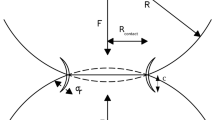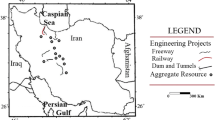Abstract
Quality estimation of rock aggregate raw materials is often performed with mechanical tests on aggregates crushed with laboratory crushers. However, standardised mechanical tests are intended for testing products, not raw materials. Different laboratory crushers produce aggregates with varying shape properties [flakiness index (FI), shape index and surface roughness], and this has a distinctive impact on the results from mechanical tests. Setting of crushers also plays an important role in laboratory crushing of aggregates and it should be adjusted according to required particle size. Four laboratory crushers and three apparati to measure resistance to wear by abrasion from a studded tyres test (A N test) from three laboratories were compared and studied. The A N test was carried out according to the EN standard and on bar-sieved samples in order to find how FI or surface roughness affects the A N value.
Résumé
L’estimation de la qualité d’un matériau, destiné à l’élaboration de granulats, est souvent établie grâce à des essais mécaniques réalisés sur des matériaux obtenus à partir de concasseurs de laboratoire. Cependant, les essais mécaniques normalisés ont été définis pour tester les produits élaborés et non le matériau brut. Différents concasseurs de laboratoire produisent des granulats avec des propriétés de forme variables (indice d’aplatissement, indice de forme, rugosité de surface) et ceci porte à conséquence sur les résultats des essais mécaniques. Le réglage des concasseurs de laboratoire joue également un rôle important et doit permettre d’obtenir la granularité requise. Les résultats issus de quatre concasseurs de laboratoire et de trois abrasivimètres du type pneus cloutés (essais A N) ont fait l’objet de comparaisons. Les essais AN ont été réalisés suivant la norme EN et sur des échantillons issus de cribles à barreaux afin de mettre en évidence l’influence de l’aplatissement et de la rugosité de surface sur les valeurs d’abrasivité A N.


Similar content being viewed by others
Reference
Briggs CA, Bearman RA (1996) An investigation of rock breakage and damage in comminution equipment. Miner Eng 9:489–497
Briggs C, Evertsson CM (1998) Shape potential of rock. Miner Eng 11:125–132
Chi G, Fuerstenau MC, Bradt RC, Ghosh A (1996) Improved comminution efficiency through controlled blasting during mining. International J Min Process 47:93–101
CEN, European Committee for Standardisation (1996) EN 1097-1, Tests for mechanical and physical properties of aggregates. Part 1: Determination of the recistance to wear (Micro-Deval), Brussels, 10 pp
CEN, European Committee for Standardisation (1997) EN 933-3, Tests for general properties of aggregates. Part 3: Determination of particle shape. Flakiness index, Brussels, 7 pp
CEN, European Committee for Standardisation (1998a) EN 1097-2, Tests for mechanical and physical properties of aggregates. Part 2: Methods for the determination of resistance to fragmentation, Brussels, 22 pp
CEN, European Committee for Standardisation (1998b) EN 1097-9, Tests for mechanical and physical properties of aggregates. Part 9: Determination of the resistance to wear by abrasion from studded tyres, Brussels, 7 pp
CEN, European Committee for Standardisation (1998c) EN 933-1, Tests for geometrical properties of aggregates. Part 1: Determination of particle size distribution. Sieving method, Brussels, 7 pp
CEN, European Committee for Standardisation (1999a) EN 933-4, Tests for geometrical properties of aggregates. Part 4: Determination of particle shape—Shape index, Brussels, 10 pp
CEN, European Committee for Standardisation (1999b) EN 932-2, Tests for general properties of aggregates. Part 2: Methods for reducing laboratory samples, Brussels, 16 pp
CEN, European Committee for Standardisation (2001) EN pr13043, Aggregates for bituminous mixtures and surface treatments for roads, airfields and other trafficked areas, Brussels, 40 pp
Evertsson CM (2000) Cone crusher performance. Ph.D. Thesis, Chalmers University of Technology, Göteborg.
Fernlund JMR (1998) The effect of particle form on sieve analysis: a test by image analysis. Eng Geol 50:111–124
Heikkilä P (1991) Improving the quality of crushed rock aggregate. Acta Polytech Scand 96:169
Jern M (2001) Determination of the damaged zone in quarries, related to aggregate production. Bull Eng Geol Environ 60(2):157–166
Jokinen J (1990) Mikrorakoilu kalliomurskeessa [In Finnish, Microcracks in pavement aggregate, English summary]. Unpublished Lis. Thesis, Helsinki University of Technology, Materials Science and Rock Engineering, pp 88
Korsman K, Koistinen T (1998) Suomen kallioperän yleispiirteet. [In Finnish, The general features of Finnish bedrock]. In Lehtinen M, Nurmi P, Rämö O (eds) Suomen kallioperä, Suomen geologinen seura, pp 375
Lizotte YC, Scoble MJ (1994) Geological control over blast fragmentation. Can Min Metall Bull 87(983):57–71
Mäkitie H, Härmä P, Lappalainen K (1994) Geology and strength properties of high-quality precambrian crushed rock aggregate: an example from the Koskenkylä quarry, Finland. In Oliviera R, Rodrigues LF, Coelho AG, Cunha AP (eds) Proceedings Seventh International Congress International Association of Engineering Geology, Lisboa, Portugal, pp 3193–3200
PANK (Finnish Pavement Technology Advisory Council) (1995) PANK-2207 Kiviainekset, kuulamyllykoe, raaka-ainetesti [In Finnish, Aggregates, the resistance to wear from studded tyres test, raw material test], 4 pp
PANK (Finnish Pavement Technology Advisory Council) (2000) Finnish Asphalt Specifications. ISBN 951-97197-6-8, pp 74
Tolppanen P, Stephansson O, Stenlid L (2002) 3-D degradation analysis of railroad ballast. Bull Eng Geol Environ 61:35–42
Vuorinen J (1999) Kuulamylly-ja Micro-Deval-kokeiden tulosten vastaavuus. [In Finnish, The correlation between studded tyre test and Micro-Deval tests]. Tielaitoksen selvityksiä 30:27
Acknowledgements
The authors are grateful to Veli Suominen (Geological Survey of Finland), Akseli Torppa, and Paula Kosunen (University of Helsinki) for constructive consultation. We also wish to thank Hanna Järvenpää of Lohja Rudus Oy Ab, Lars Forstén of Lemminkäinen Ltd, Heli Randell and Mika Stendahl from the Finnish Road Enterprise for valuable consultations and providing laboratory facilities and to Anthony Meadows for language revision. The Graduate School in Rock Engineering and Foundation for Research of Natural Resources in Finland gave the financial support.
Author information
Authors and Affiliations
Corresponding author
Rights and permissions
About this article
Cite this article
Räisänen, M., Mertamo, M. An evaluation of the procedure and results of laboratory crushing in quality assessment of rock aggregate raw materials. Bull Eng Geol Environ 63, 33–39 (2004). https://doi.org/10.1007/s10064-003-0218-1
Received:
Accepted:
Published:
Issue Date:
DOI: https://doi.org/10.1007/s10064-003-0218-1




